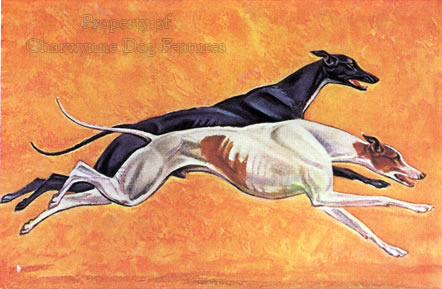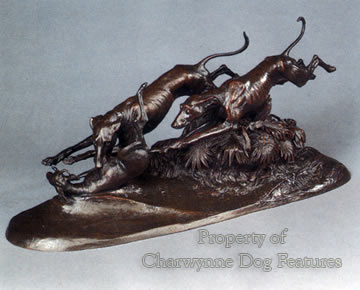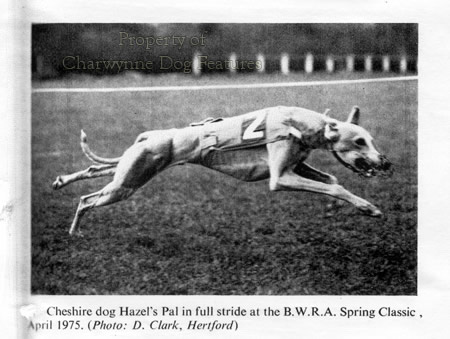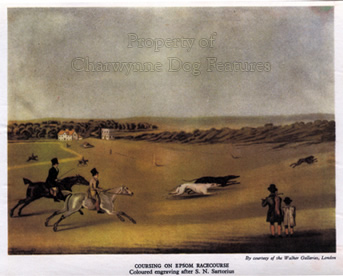851 ASSESSING A SIGHTHOUND
ASSESSING A SIGHTHOUND
by David Hancock
 Immense Flexibility
Immense Flexibility
In his most informative book An Eye for a Dog (Dogwise Publishing, USA, 2004), conformation expert Robert Cole has written: “The Greyhound demonstrates in profile the conformation man has selected for speed at the gallop. The shoulder blade is not as well laid-back as endurance trotting breeds and the upper arm is more open…The Greyhound’s front pastern is long…At the fast double-suspension gallop this pastern bends 180 degrees to lie flat on the ground, shortening the leg as the shoulder passes over it. After the Sighthound’s shoulder passes over the paw, this pastern springs back up contributing an upward thrust. Each of these forequarter styles has been selected by man to perform a specialized function resulting in a certain structure…” The immense flexibility needed in the sighthound physique has to be foremost in every breeder’s mind. Robert Cole was the creator of the much-misunderstood expression TRAD – tremendous reach and drive, in judging Salukis. He himself pointed out however that “it must be remembered that long distances on the hunt are covered by the Saluki at the trot, not the gallop, therefore action at the trot should appear seemingly effortless, conserving energy for the final fast gallop.” In designing for great speed, there is still great need for the sighthound to get to the crucial final stage of the hunt; a sighthound on the move is not just a sprinter and its anatomy has to permit the sustained trot as well as the dynamic dash. Judges really do need to have ‘the moving dog’ in their mind’s eye in the ring.
Under-exercised Exhibits
In his informative The Practical Guide to Showing Dogs of 1956, Captain Portman-Graham wrote: "The fact that a dog is structurally sound is not in itself sufficient to ensure that it will always win at shows. It is of paramount importance that it must be...at the highest standard of condition...Perhaps one of the biggest advantages which dog showing confers on the dog as an animal is the care which must be bestowed upon it." If unfit dogs with poor muscular condition can win at dog shows, then the whole argument that such shows improve dogs is totally destroyed. Dogs which are inadequately exercised and merely wheeled out for the next show can be so easily identified by any competent judge and quickly thrown out of the ring that such an insidious practice, both for dogs and the dog game, can be ended. Sighthounds are first and foremost hunting dogs. Unfit unexercised sighthounds look just that and reveal more about ‘the other end of the lead’ than most exhibitors realize! Judges must rate condition as much as form.
Under-muscled Exhibits
Portman-Graham went on to write: "...exercise is a vital consideration in maintaining any breed of show dog in bloom, health and vigour...When one watches the beautiful muscles of a racehorse one sees a similarity between a dog's muscles which have been developed correctly and naturally, and ripple in movement.” Yet there is evidence of lack of muscular tone and development in so many sighthound rings, even at many lurcher shows today. One of the saddest sights at a pedigree dog show has to be an unfit under-muscled unexercised exhibit from a sighthound breed; these dogs were born to run! What value would such a neglected undervalued hound have for a hunter? That is the ultimate query for any competent judge; the whole exercise of showing a dog is the pursuit of top class animals, the identification of future breeding material, not a parade of possessions.
Value of a Sequence
Movement demonstrates soundness, or reveals flawed physiques; the initial overall appraisal can reveal symmetry and allow assessment of the whole dog. The closer hands-on examination allows the slope of shoulder, the strength of loin, the muscular development, the skeletal frame and the construction of the jaw to be checked. But the sequence of the examination is crucial. For me, it is logical to view the whole dog standing and moving before a closer look is given. And by moving I mean three dimensional: going away, going across and then heading directly for me. I am seeking effortless locomotion, a balanced harmonious economical gait and no excessive action, either to the side or off the ground. Does the dog look as though it could go on like this for miles? Would the judge want to take the dog home!
Rewarding Soundness
Any closer examination has, for me, to follow a set sequence: head, jaw, eyes and ears, neck and shoulders together, back and loins together, set of tail and pelvic slope together. Then to the lower case: spread and elbows together, front legs AND feet, thorax and tuck-up, hind-limbs AND feet then coat and character. Judging character isn't straightforward; I go for the look in the eye, the tail action and the confident body language. We all surely want keen willing up-on-their-toes sporting dogs. Without a set sequence I'd be worried I'd miss something. In the end, of course, what the dog can do will always be more important than what it looks like. But sound construction, backed by physical fitness, will always allow a sporting dog to excel and that is the task of every sighthound judge: to reward soundness and fitness for function, not showiness. Winning show-dogs get bred from; but, truly, who is honestly proud of a kennel full of incapable exhibitionists, useless show-offs!
Sighthound Good Fortune
The sighthound breeds, the early show Greyhounds, Deerhounds and Borzois particularly, came to us from the coursing fields of the world and that is their good fortune. Function and performance shaped their form and decided their perpetuation. Some companion breeds are the result of man’s whims and can range from the cuddly baby-substitutes to sheer oddities in appearance. Not every courser was happy when the show ring claimed the sighthound breeds. In his The Greyhound of 1930, James Matheson wrote: “As a sporting dog, the show greyhound has all but ceased to exist. It is not only that his conformation militates against his chances of success in the chase, but his very inclinations to pursue and kill are sadly lacking through disuse.” Some modern welfarists might welcome the latter but no sighthound admirer wants to lose the essential conformation of the coursing dog. In his The Greyhound and Coursing of 1921, Adair Dighton writes: “Someone, possibly more than one, will criticize this chapter and say, or write, that I have said nothing about shape or make…They run and win in all shapes and of all makes, and so long as a greyhound can gallop and work it does not matter what he looks like. This work is not written for the owners of those apologies, ‘The Exhibition Greyhound’, but for the coursing man, and he, I know, will understand my point.”
Dual Purpose Hounds
Stars of the track and coursing field have also triumphed in the show ring from the very beginnings of the show scene, as I have set out in Chapter 2 and earlier in this one . In his The Courser’s Guide of 1896, Thomas Jones wrote: “…many of the most worthless greyhounds in the coursing field take prizes at shows. One or two exceptions to this rule I will, however, mention; the first being Jenny Jones, who was as good-looking a bitch as ever went out of slips…After her running career she was shown a great number of times, and her record in this way, I believe, beats any greyhound who has been on the bench either before or since. The second one is that good-looking bitch, Bit of Fashion, whose performances are well known to all coursing men…She may be set down therefore as not only being a perfect model, but also as possessing all the good qualities of a first-class greyhound in the coursing field.” All true devotees of the sighthound breeds are surely seeking ‘a perfect model’ – handsome, yes, but essentially a running dog.
“The subject of judging opens up a wide range of discussion, and there is no gainsaying the fact that there are a great number of inefficient young judges about. One can’t get a real knowledge of dogs in a few months, or even in a few years; and although I am always out to give the novice a chance, discrimination should be used. To see some of these ‘gentry’ at shows makes one positively shiver. Many a time I have seen them ‘performing’, when giving an exhibition of how a dog should not be judged…”
Points of the Dog by TW Hancock Mountjoy, Eveleigh Nash & Grayson Ltd., 1927.
“…your turn may come to be a judge one day. It is a great responsibility. An unsound criterion of one individual of points necessary to make a dog a winner can influence a breed for the worse for generations, and slowly eliminate it from the scene by the demand made on stamina if the faulty criterion is persisted in. Is it too much to ask that the standards of Show points should be revised, with the well-being of the breed in mind? And may the committee that does this beneficent task have among its members an experienced veterinary surgeon accompanied by a geneticist?”
The Right Way to Keep Dogs by RCG Hancock, BSc, MRCVS, Elliot Books, 1956. (Half a century later, this is now happening).
“It is well to remember that ‘perfection of form’ does not ensure perfection of movement, nor necessarily any great improvement in stamina. A vast number of greyhounds fulfil all the requirements of the most exacting standard until such time as they called upon to move.”
All About the Greyhound by Anne Rolins, Rigby Publishers, 1982.
“Movement, on some that I know have won well, was all over the place, wide coming and going or two legs coming out of the same hole…Muscle, some carried far too much, a show Whippet should have long, flat muscle not racing dog bulgy muscle. At the other end of the scale dogs so narrow that you could not get your hand between their forelegs and had the appearance of two shadows glued together.”
Critique on a championship Whippet show of 25th September, 2011.
“Now I myself shall tell you by what means you should judge the fast and well-bred ones…First, then, let them stand long from head to stern…Let them have light and well-knit heads…Let the neck be long, rounded and supple Broad breasts are better than narrow, and let them have shoulder-blades standing apart and not fastened together…loins that are broad, strong not fleshy, but solid with sinew…flanks pliant…Rounded and fine feet are the strongest.”
The Greek historian Arrian, in his treatise of the second century AD.
“So handsome are greyhounds, so graceful in outline, that they would be worthy of the chisel of a Phidias. At their best, in the form cultivated for the show ring by breeding for beauty rather than performance, they are particularly pleasing, and a really good one seldom fails to catch the eye of those who judge the variety classes open to all breeds. The points desired in the show dogs are such as should be required in the coursing or racing dogs. The general description prefacing the standard of points drawn up by the Greyhound Club of Great Britain reads: ‘In judging greyhounds it is essential that the judge should bear in mind that the beautiful lines of the breed are one of its biggest assets. This breed is essentially built for speed, ability to bend and turn with his game, and possess the build (or formation) which will fit him for his work in the field in combination with the graceful lines of a thoroughbred. It is absolutely essential that he should be well balanced throughout.’”
Sporting Dogs by A Croxton Smith, Country Life Ltd., 1938.
“The more one judges the more one comes to appreciate that truly outstanding dogs are a rarity and that the standard of most of the dogs that one is asked to judge falls somewhere between acceptable and very good. A great dog once gone over is never forgotten and lives on in the memory forever. When judging dogs that are perhaps best described as average, one has to be prepared to compromise. Judges do vary in the extent to which they choose to penalize specific faults and this can easily result in a multiplicity of opinion with regard to the placing of the same exhibits by different judges or indeed by the same judge on a different day.”
Critique from the Saluki judge at the Manchester Championship Show of 2011.